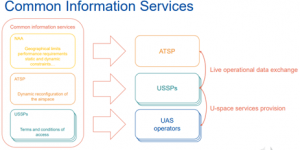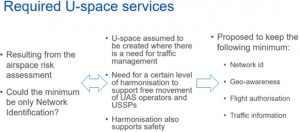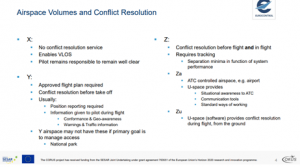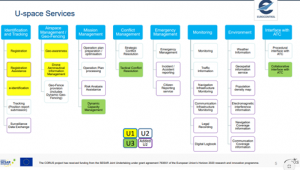By Jenny Beechener
AW-Drones latest update on technical standards under development to support U-space implementation in Europe identifies continued need for definition and harmonisation in specific areas, for example the requirement for a list of operational standards that drone operators, manufacturers and other stakeholders can use to demonstrate compliance with existing regulations.
Central to standards development, the European UAS Standards Coordination Group (EUSCG) is responsible for the Rolling Development Plan (RDP) which provides an overview of all major standardisation activities. EUSCG Chair and EUROCAE Secretary General Christian Schleifer said the fifth edition of the RDP released in September 2020 tracks the status of standards development. The chart above shows ongoing development (orange) and published standards (green) with target date, the group responsible, and brief description (on the left). “This is a living document. We meet 3-4 times a year to make sure we have all the current development activities in the current RDP, understand where the needs are, understand where are going with the regulations, and publish in timely manner. We complement the regulatory frame.” The EUSCG recommends to the European Aviation Safety Agency (EASA) standards needed for acceptable means of compliance.
AW-Drones, a three-year EU Horizon 2020 funded programme addressing the lack of standards harmonisation and providing guidance to EU drone regulators, presented mid-programme results in a webinar on 12 November 2020 delivered by EU experts.
AW-Drones identifies those U-space services for which standards are currently available, those under development, and those still requiring standards in the following slide presented by Andres van Swalm, Co-found and CPO of Unifly.
DG MOVE Commissioner Nicolas Eertmans said several areas in the regulatory framework still require standardisation. He anticipates publication of the Commission’s draft regulation at the beginning of 2021 and said the draft regulatory package focuses on a number of key areas. It identifies two types of services: Common Information Services (CIS) and U-space services.
“Common Information Services need to be made available by air traffic service providers, U-space service providers (USSPs), U-space operators to be able to safely operate U-space, and have common information and common understanding of the geographical extent of the airspace and also the traffic operating in it,” said Eertmans. “With no support for a single centralised monopolistic service provider, instead certified ANSPs and USSPs will provide part of common information, and authorities provide rest of common information and do not need to be certified.” Standards are being developed to support this distributed model.

“Of six U-space services required, four are currently mandated by EASA: Network ID, geo-awareness, flight authorisation and traffic information. We also propose weather information service and conformity assessment services.” Further services may be defined, while application of services depends upon the risk assessment by the relevant national regulatory authority.
“In the initial phase, we segregate manned and unmanned traffic for safety reasons, but we would allow general aviation to enter U-space with a requirement to be electronically conspicuous to USSPs.” Technology agnostic, transponders are not specified leaving the market open to technology such as FLARM. “UAS operators will subscribe and pay for U-space services,” he added.

SESAR U-space research also contributes to standards development and includes publication of a Concept of Operations (Conops) in 2019 by the U-space CORUS project members. Eurocontrol Technical Coordinator Andrew Hately said: “We divided the sky into three volumes, each representing an area of different risk, each with different access conditions and different services being provided.” These range from X (low risk) visual line of sight, to Y (some technical requirements such as surveillance, equipment carriage, navigational performance, flight plan approval, and conformance/position reporting, to Z (high risk tactical conflict resolution). The Conops lists the U-space safety services necessary to support up to four levels of service delivery, U4 representing the most advanced. “The Commission regulation is the gateway to U2.” Hately predicts, “the release of U-space regulation in early 2021 will unleash a wave of deployment as many are ready to move to implementation but first need the regulation that describes the precise details they need to follow.”


AW-Drones due to hold its third workRemove featured imageshop in mid-2021 which will review all standards and principles for autonomous UAS certification with the aim of identifying the appropriate standards for every application, and validating standards for each category.
For more information visit:




